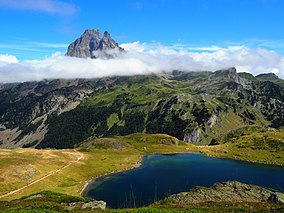Pyrénées National Park
| Pyrénées National Park | |
|---|---|
| Parc national des Pyrénées | |
 | |
| Location | Pyrenees, France |
| Nearest city | Luz-Saint-Sauveur |
| Coordinates | 42°49′39″N 0°10′33″W / 42.82750°N 0.17583°W |
| Area | 458 km2 (177 sq mi) |
| Established | 23 March 1967 |
| Governing body | Parcs nationaux de France |
| Official name | Pyrénées - Mont Perdu |
| Type | Mixed |
| Criteria | iii, iv, v, vii, viii |
| Designated | 1997 (21st session) |
| Reference no. | 773 |
| Region | Europe and North America |
| Extensions | 1999 |
Pyrénées National Park (French: Parc national des Pyrénées) is a French national park located within the departments of Hautes-Pyrénées and Pyrénées-Atlantiques.[1][2] The park is located along the border of France and Spain along the Pyrenees Mountains, with a scenic landscape offering a variety of outdoor activities including hiking, skiing, mountain climbing and observing wildlife.[3][4]
Description
Located in the Pyrenees mountains, Pyrenees National Park protects many limestone landforms, including karst valleys and caves. Repeated glaciations within the Quaternary created multiple cirques such as the immense Cirque de Gavarnie and large U-shaped valleys within the park.[5] The limestone originated from the Cretaceous and Eocene periods. Tectonic uplift has created deep canyons, and, during the Quaternary, repeated glaciations carved cirques and large U-shaped valleys.[5]
The park was created in 1967 as a natural heritage site without barriers or fences where animals are totally free.[6] Devoted to preserving biodiversity and landscapes, as well as studying wildlife and plant species, the park is home to 70 different species of mammals.[7] Threatened species found in the park include the lammergeier, Pyrenean desman, Pyrenean chamois, and capercaillie.[8] A small population of bears also inhabit the park. At least 124 plant species have been observed within the national park, including 25 that are endemic to the Pyrenees mountains.[9]
The eastern portion of the national park was inscribed on the UNESCO World Heritage List in 1997, forming part of the French section of the Pyrénées – Mont Perdu World Heritage Site that straddles the border between France and Spain.[10][4] The park also borders on the Lacs de Carnau.[citation needed]
-
Pyrénées National Park, here on the foothills of the Aspe Valley, on the border between France and Spain
-
The Pyrénées National Park, Cirque de Gavarnie, Gave de Gavarnie river
See also
References
- ^ Le Parc national des Pyrénées (2014). Le Parc national des Pyrénées, un établissement public. Retrieved on 2014-04-19 from "Le Parc national des Pyrénées, un établissement public". Archived from the original on 2016-01-29. Retrieved 2015-12-28..
- ^ Fact sheet Archived 2018-01-21 at the Wayback Machine on hautes-pyrenees.gouv.fr.
- ^ Pyrenees National Park (Parc National des Pyrenees). Trip Advisor. Retrieved on 2008-02-02 from http://www.tripadvisor.com/Attraction_Review-g187166-d254589-Reviews-Pyrenees_National_Park_Parc_National_des_Pyrenees-Midi_Pyrenees.html.
- ^ a b "Pyrénées - Mont Perdu". UNESCO World Heritage Centre. United Nations Educational, Scientific, and Cultural Organization. Retrieved 24 October 2021.
- ^ a b García-Ruiz, José M.; Valero-Garcés, Blas L.; Beguería, Santiago; López-Moreno, Juan I.; Martí-Bono, Carlos; Serrano-Muela, Pilar; Sanjuan, Yasmina (2014). "The Ordesa and Monte Perdido National Park, Central Pyrenees". Landscapes and Landforms of Spain. World Geomorphological Landscapes: 165–172. doi:10.1007/978-94-017-8628-7_14. hdl:10261/108112. ISBN 978-94-017-8627-0.
- ^ Pyrénées National Park website. Archived 2008-01-15 at the Wayback Machine Retrieved on February 2, 2008
- ^ Discovering Pyrenees National Park. Official Web site. Retrieved on 2008-02-02 from "Welcome to the Pyrenees National Park". Archived from the original on 2008-06-12. Retrieved 2008-06-12..
- ^ Feuillet, Thierry; Sourp, Eric (September 2011). "Geomorphological Heritage of the Pyrenees National Park (France): Assessment, Clustering, and Promotion of Geomorphosites". Geoheritage. 3 (3): 151–162. doi:10.1007/s12371-010-0020-y. S2CID 67817610.
- ^ Gauthier, Perrine; Foulon, Yoann; Jupille, Olivier; Thompson, John D. (February 2013). "Quantifying habitat vulnerability to assess species priorities for conservation management". Biological Conservation. 158: 321–325. doi:10.1016/j.biocon.2012.08.012.
- ^ "Pyrenees-Mont Perdu". United Nations Environment Program - World Conservation Monitoring Centre. January 2000. Archived from the original on 2008-07-18. Retrieved 2008-08-12.
External links



